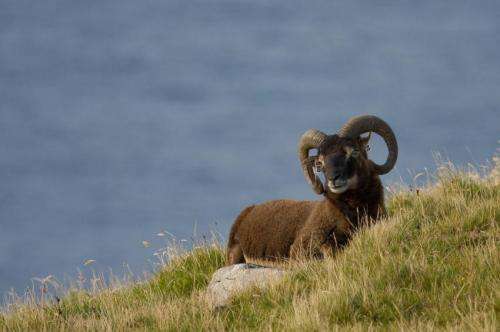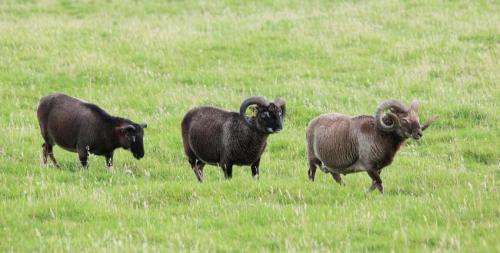Soay ram on the island of Hirta, St Kilda. Credit: Arpat Ozgul
(Phys.org) —A team of researchers from the U.K. and Australia, working with sheep data obtained from a small island off the coast of Scotland has learned why it is that some sheep have large horns, while others do not. In their paper published in the journal Nature, the team describes how they studied data obtained over a 20 year period to discover the seeming contradiction with the sheep.
Soay is a small breed of bighorn sheep—they live in mountainous terrain on an island called Hirta and have what would appear to be a genetic anomaly. Some of the males have extremely large horns, while the horns of others are much smaller. Because research has shown that the males that have the larger horns are much more successful at mating, there is the question of why all the males don't have large horns.
To find out, a team working in a prior effort studied the genes of the sheep and discovered a particular allele (alternative forms of the same gene) responsible for horn size, called Ho. The sheep all have two of them—those sheep that have two of the large-size variant have large horns, while those with two of the small size variant had small or even no horns at all. But there was a catch. Sheep with smaller horns, for reasons that aren't yet known, tend live longer.
Three rams on the island of Hirta, St Kilda with different horn morphologies. The male on the left displays the scurred (vestigial) phenotype, meaning that it cannot compete with the normal-horned males for access to mates during the rut. Credit: Peter Korsten
In this new effort the researchers analyzed data collected from 1,750 sheep and found that there is a third category of sheep, those that have one type of each allele—they get the benefits of both—the live longer than the sheep with the biggest horns and mate more often than the sheep with tiny horns. This, the researchers suggest, explains why big horns haven't become predominant—though they may lead to producing more offspring in the short time, those with smaller horns win out in the end by breeding over more seasons. Thus, natural selection results in splitting the difference to ensure the best chance of survival for the species as a whole.
The researchers note that the same allele exists in both humans and mice, and has been found to be involved in bone density and sexual development. They suggest more research will need to be conducted to discern if the gene is a factor in either longevity or successful procreating in either species
More information: Life history trade-offs at a single locus maintain sexually selected genetic variation, Nature (2013) DOI: 10.1038/nature12489
Abstract
Sexual selection, through intra-male competition or female choice, is assumed to be a source of strong and sustained directional selection in the wild. In the presence of such strong directional selection, alleles enhancing a particular trait are predicted to become fixed within a population, leading to a decrease in the underlying genetic variation. However, there is often considerable genetic variation underlying sexually selected traits in wild populations, and consequently, this phenomenon has become a long-discussed issue in the field of evolutionary biology. In wild Soay sheep, large horns confer an advantage in strong intra-sexual competition, yet males show an inherited polymorphism for horn type and have substantial genetic variation in their horn size6. Here we show that most genetic variation in this trait is maintained by a trade-off between natural and sexual selection at a single gene, relaxin-like receptor 2 (RXFP2). We found that an allele conferring larger horns, Ho+, is associated with higher reproductive success, whereas a smaller horn allele, HoP, confers increased survival, resulting in a net effect of overdominance (that is, heterozygote advantage) for fitness at RXFP2. The nature of this trade-off is simple relative to commonly proposed explanations for the maintenance of sexually selected traits, such as genic capture ('good genes') and sexually antagonistic selection. Our results demonstrate that by identifying the genetic architecture of trait variation, we can determine the principal mechanisms maintaining genetic variation in traits under strong selection and explain apparently counter-evolutionary observations.
Journal information: Nature
© 2013 Phys.org























